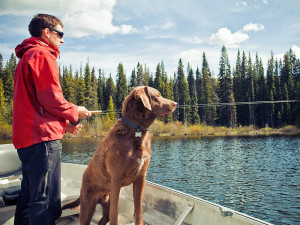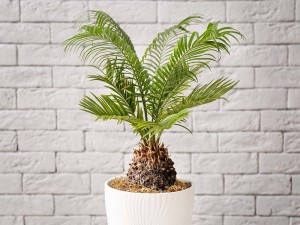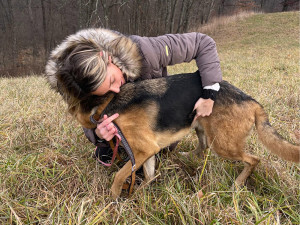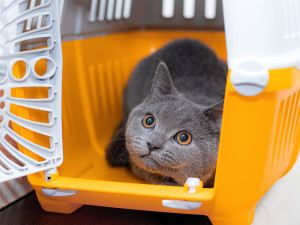How to Keep Your Pet Safe During a Hurricane and Other Natural Disasters
A VCA Animal Hospital expert explains everything you need to know about preparing for a natural disaster.

share article
T his year’s hurricane season will be worse than usual due to record high sea surface temperatures in the Atlantic, predicts The National Oceanic and Atmospheric Administration (NOAA)opens in a new tab. And it's already begun with Tropical Storm Alberto causing devastating flooding in Texas and Mexicoopens in a new tab.
Lisa Gillespie, the Regional Operations Director for VCA Sanibel Animal Hospitalopens in a new tab, is all too familiar with the dangers of tropical storms — and the threat they can pose to our pets. In September of 2022, when Hurricane Ian struck, the VCA Sanibel Animal Hospital sustained severe damage.
“Despite the building being raised, it was still inundated with over 18 inches of water on the second floor due to significant storm surge waters,” says Gillespie. The Sanibel Causeway was damaged, making the hospital inaccessible for almost a month. During this period, the lack of electricity and air conditioning exacerbated the water damage, leading to the growth of caustic mold throughout the building. The hospital then needed to be entirely gutted.
Luckily, no animals or people were hurt when the hospital was destroyed. But the experience was a harrowing one for the hospital staff and the pet parents who relied on the location. Now, VCA is reopening the VCA Sanibel Animal Hospital in a new location. The expanded space is equipped with advanced technology and allows VCA to see three times the number of patients they could before. “We are incredibly grateful for the support and patience of our community throughout this journey,” Gillespie says.
With hurricane season in swing, VCA is committed to educating pet parents on how to prepare for the weather. We talked to Gillespie about how to keep pets safe during a natural disaster.
Plan ahead
You don’t want to be in a panicked frenzy when you hear that a storm is on the way. Planning far ahead will help you stay calm when the moment comes — and keep you from forgetting anything important. “We recommend that pet owners schedule annual phone and calendar reminders to prepare an emergency supply kit prior to the start of the hurricane season to avoid the chaos of impending storms,” Gillespie says.
Find a pet-friendly shelter in advance
Gillespie adds that an important element to consider in advance is where the pet will go in the event of an evacuation. According to a survey by PetSmart Charitiesopens in a new tab, 90 percent of pet parents wouldn’t leave their home during a storm if they couldn’t bring their pet with them. Many also stated that they would give up a spot in a shelter if they couldn’t bring their pet. Abandoning a pet is unthinkable, and Gillespie agrees that a pet should never be left alone during a tropical storm.
If you can, make plans with a trusted friend outside of the evacuation area who would be able to house your pet. Talk to your veterinarian, groomer, or a local boarding facility about whether or not they could shelter your pet during an emergency. Search for any pet-friendly emergency shelters ahead of time; your local animal shelter, veterinarian, or animal control may be able to let you know of any near you. The VCA recommends keeping a list of pet-friendly hurricane shelters and their contact information.
Regularly update your pet’s microchip information
Gillespie also recommends making sure your pet’s microchip information is up-to-date with your microchip company, including two to three emergency contact numbers. “After Hurricane Ian, we were able to reunite four pets who were lost with their owners thanks to their emergency contacts,” she says.
Stay informed
The sooner you know about a potential storm, the better you can prepare yourself and your pet. Be aware of the dates of your location’s hurricane season. “Staying informed about hurricanes is crucial for pet owners,” Gillespie says. “I recommend relying on trusted local and national sources such as weather alerts and news apps for regular updates.”
The VCA suggests downloading the FEMA app, which provides real-time weather alerts and safety resources.
Create a go-bag
If you need to evacuate, you’ll want to reach for an already-assembled bag full of your pet’s essentials. This should include a crate, comfort items, a portable bowl, bottled water, and an extra leash and collar. Add medical records and a photo of your pet. Crucially, your go bag should include a first-aid kit — more on that below.
Gillespie advises adding general hurricane emergency supplies, such as an instant cold pack, disposable gloves, resealable plastic bags, and a flashlight with extra batteries.
One component of the go-bag should be instructions and information for a caretaker in case you become injured or your pet is separated from you. “In a Ziploc bag, place a picture of your pet and an information sheet all about them and their care, feeding instructions, allergies, medications,” Gillespie says. “Include your contact information and 2-3 emergency contacts. Include a copy of their vaccinations and their veterinarian's information. Remember, if you don’t have phones or power, their facility may not either.”
Prepare a pet first-aid kit
A first-aid kit is an absolute must. Hopefully, your pet will stay perfectly safe throughout the experience, but you’ll want to be prepared for health needs big and small. It’s a good idea to familiarize yourself with the kit before you need it, Gillespie says, so you know where everything is.
First things first: You’ll need a first-aid manual. Gillespie recommends a “pet-specific first-aid book or manual from reputable sources like AVMA, AAHA, or the Red Cross.”
Add basic medical supplies like various sizes of gauze pads, adhesive tape, non-stick bandages, cotton balls and swabs, blunt-tipped scissors, tweezers, and a rectal digital thermometer, says Gillespie. Include antiseptics like hydrogen peroxide, isopropyl alcohol, and a sterile eye wash or saline solution.
Just in case, be sure you have bandaging supplies on hand. Elastic bandages, conforming bandages, Telfa pads, and vet wrap are some must-haves. Gillespie also recommends styptic powder for stopping bleeding and a hemostat and needle-nose pliers in case you have to remove any foreign objects.
Be sure to include a minimum two-week supply of any prescription medications your pet needs. Regularly check that medications in the first aid kit are up to date and aren’t expired. You may also want to bring antihistamines, with the guidance of a veterinarian.
Lastly, Gillespie recommends a handful of specialty items including a tick remover, activated charcoal in case your pet ingests something toxic, a first-aid card with emergency numbers, an emergency blanket, splints, and a pill cutter and crusher for pets who take medication.
You can download a free copy of the VCA 2024 Hurricane Preparedness Playbook at the link below.

Sio Hornbuckle
Sio Hornbuckle is a writer living in New York City with their cat, Toni Collette.
Related articles
![Man fishing with his dog on a lake.]() opens in a new tab
opens in a new tabDogs Are Contracting an Illness From California Lakes and Rivers
Vets advise keeping your pup away from raw fish caught in rivers and lakes.
![A Sago Palm in a white pot against a grey brick background]() opens in a new tab
opens in a new tabTwo Georgia Dogs Died After Consuming the Toxic Sago Palm
It looks cute, but this plant is incredibly deadly to dogs. Here’s everything you need to know.
![Woman in a coat soothing a rescued German Shepherd dog in a field outside]() opens in a new tab
opens in a new tab9 Tips To Find a Lost Dog—Fast
Buddha Dog Rescue and Recovery founder Nicole Asher’s pro tips for getting your missing pup home safe.
![Gray cat in a yellow pet carrier]() opens in a new tab
opens in a new tabHow to Prepare Your Pet for a Natural Disaster
The East Coast just had a rare earthquake. A vet breaks down what to include in an emergency go-bag for your pet in times like this.
![a dog from Curb Your Enthusiasm wearing a coyote vest]() opens in a new tab
opens in a new tabPay Attention to the “Curb Your Enthusiasm” PSA for Dog Coyote Vests
Clearly, Larry David wants your pup to be safe from coyotes. Here’s why you should, too.
![Woman collecting flowers and dog entering the river surrounded with trees.]() opens in a new tab
opens in a new tabA Parasite That Can Be Deadly for Dogs Has Been Found in California
Experts are warning pet parents to keep their pups out of the Colorado River.







